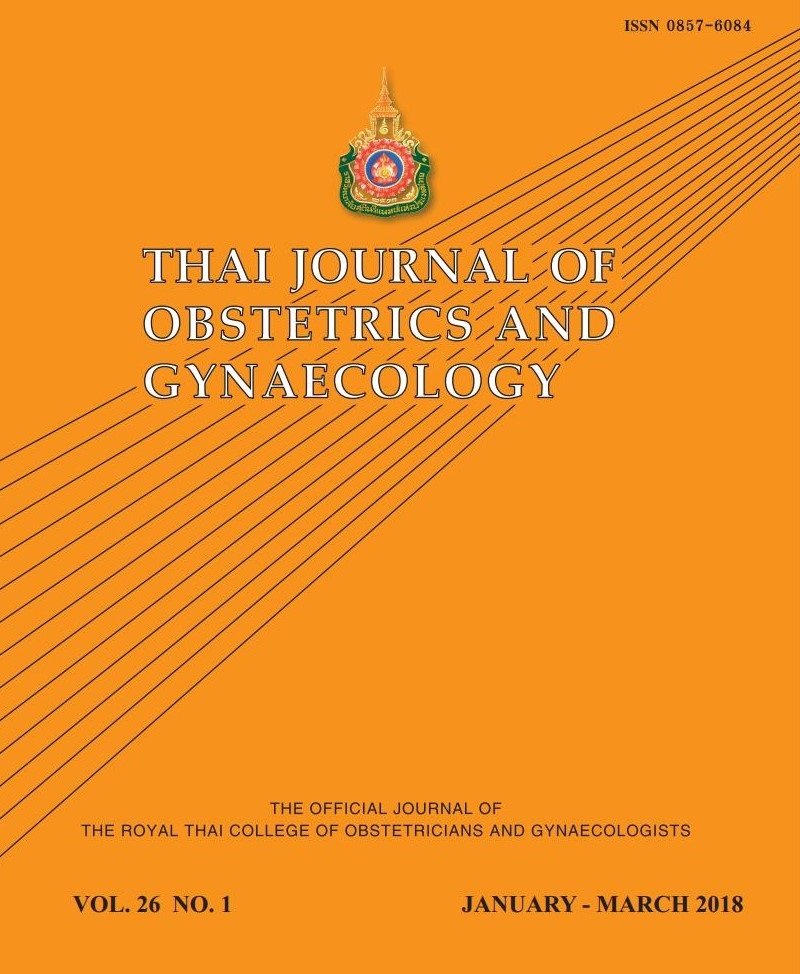Membrane Stripping to Reduce Postdate Pregnancy: A randomized controlled trial
Main Article Content
Abstract
Objective: To compare delivery before 40 weeks of gestation between the pregnant women who had membrane stripping and those with no intervention.
Materials and methods: One hundred and seventy-eight pregnant women, gestational age of 38 weeks or more who attended antenatal care clinic at Khon Kaen Hospital from January to July, 2016 were randomized into two groups: membrane stripping group and no intervention group. The proportion of pregnant women who delivered before 40 weeks of gestation was analyzed.
Results: Baseline characteristics were similar between groups. The proportion of women who delivered before 40 weeks of gestation in membrane stripping group was significantly higher than no intervention group (69.3% VS 51.1%, p=0.01) (RR=0.6, 95% CI 0.4-0.9).
There was no significant difference in cesarean section rate, maternal complications and neonatal outcomes between groups.
Conclusion: Membrane stripping can reduce postdate pregnancy.
Keywords: postdate pregnancy, membrane stripping
Article Details
References
2. Galal M, Symonds I, Murray H, Petraglia F, Smith R. Postterm pregnancy: Facts Views Vis Obgyn 2012;4:175-87.
3. Nicholson JM, Mellar LC, Kellar GM. The impact of the interaction between increasing gestational age and obstetrical risk on birth outcomes: evidence of a varying optimal time of delivery. J Perinatol 2006;26:392-402.
4. ACOG (American College of Obstetricians and Gynecologists). Induction of labor. ACOG Practice Bulletin No.107 2009.
5. Cunningham FG, Leveno KJ, Bloom SL, Spong CY, Dashe JS, Hoffman BL, et al. Induction and augmentation of labor. In: Williams Obstetrics.24th ed. New Yolk: Mc Graw Hill 2014:523-34.
6. Boulvain M, Stan CM, Irion O. Membrane sweeping for induction of labour. In: The Cochrane Collaboration, editor. Cochrane Database of Systematic Reviews [Internet]. Chichester, UK: John Wiley & Sons, Ltd; 2005 [cited 2016 Nov 16]. Available from: https://doi.wiley.com/10.1002/14651858.CD000451.pub2
7. Kashanian M, Akbarian A, Baradaran H, Samiee MM. Effect of membrane sweeping at term pregnancy on duration of pregnancy and labor induction: a randomized trial. Gynecol Obstet Invest 2006;62:41–4.
8. Ugwu EO, Obi SN, Iferikigwe ES, Dim CC, Ezugwu FO. Membrane stripping to prevent post-term pregnancy in Enugu, Nigeria: a randomized controlled trial. Arch Gynecol Obstet 2014;289:29–34.
9. ACOG (American College of Obstetricians and Gynecologists). Method for Estimating Due Date. Committee opinion No.611 2014.
10. Mishanina E, Rogozinska E, Thatthi T, Uddin-Khan R, Khan KS, Meads C. Use of labour induction and risk of cesarean delivery: a systematic review and meta-analysis. CMAJ 2014 10;186:665–73.
11. de Miranda E, van der Bom J, Bonsel G, Bleker O, Rosendaal F. Membrane sweeping and prevention of post-term pregnancy in low-risk pregnancies: a randomised controlled trial. BJOG: An International Journal of Obstetrics and Gynaecology 2006;113:402–8.

